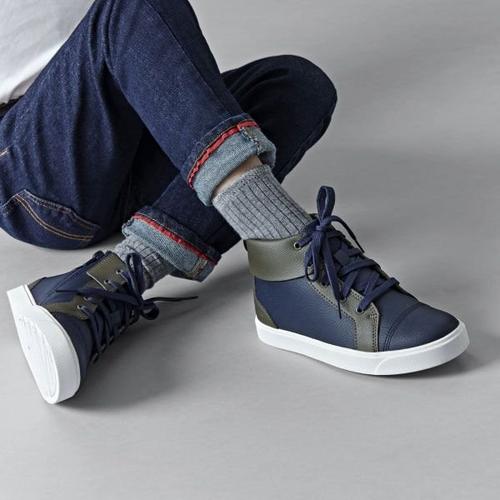How to Tie Shoelaces for Kids: A Step-by-Step Guide
Updated on:

Teaching children to tie their shoelaces is a key developmental milestone and practical life skill. From enhancing fine motor coordination to encouraging independence, learning how to tie shoes sets the foundation for personal responsibility and confidence. Whether your child is starting school or moving past riptape fastenings, this guide will walk you through each step clearly and confidently.
Why Should Children Learn to Tie Their Shoelaces?
Tying shoelaces not only keeps shoes secure but also develops essential motor skills, concentration, and independence. As children grow, so do expectations for them to manage everyday tasks without adult assistance.
Mastering shoelace tying builds hand-eye coordination and strengthens finger dexterity, crucial for tasks like writing and buttoning. It also fosters a sense of accomplishment that boosts confidence at school and home.
Additionally, being able to tie their own laces prevents tripping and ensures a snug, supportive fit, especially important in school shoes that see daily wear. Relying on others to tie their laces can delay a child's readiness for more advanced routines, so it's a skill worth teaching early.
When Should Children Learn to Tie Their Shoes?
Most children are developmentally ready to begin learning how to tie shoes between the ages of 5 and 7. However, every child is different. Some may show interest earlier, while others need extra time and patience.
Before starting, check if your child can:
- Follow multi-step instructions
- Maintain focus for short periods
- Pinch and pull objects with finger strength
- Coordinate both hands to work together
If these skills are present, your child is ready to learn. The best time to teach is when they’re relaxed and not in a rush to get out the door. Choose calm moments at home for practice, and avoid pressuring them to master it quickly. Repetition, encouragement, and patience are key.
How to Tie Shoelaces: Step-by-Step Instructions
Teaching your child to tie shoes involves breaking the process into simple, memorable steps. Below are two tried-and-tested methods that are easy to follow and ideal for beginners. Try both to see which suits your child’s learning style best.
The Bunny Ears Method
This fun and visual approach is a favourite among young learners because it involves minimal twisting and is easy to remember.

Step 1: Make an X with the Laces
Take one lace in each hand and cross them over in the middle to make an ‘X’ shape. Pull the top lace under and through the bottom of the X, just like starting a regular knot. Pull both ends tight.
Step 2: Make the First Bunny Ear
Take one lace and fold it over to make a small loop. This is your first “bunny ear.” Hold the bottom of the loop tightly so it doesn’t fall apart.
Step 3: Make the Second Bunny Ear
Now do the same with the other lace by folding it into a loop. You should now have two ‘ears’ pointing upward, one in each hand.
Step 4: Cross the Bunny Ears
Cross one bunny ear over the other to make another ‘X’ in the middle, just like you did at the beginning.
Step 5: Tuck and Pull
Take the top bunny ear and push it under the other, pulling it through the hole underneath. This step might need a little practice to get the fingers just right.
Step 6: Pull Both Ears Tight
Grab both loops firmly and pull them outward to tighten the knot. The bunny ears should now be snug and secure. Double-knot if needed to keep it from untying during play.
Why It Works The symmetry and rhythm of this method can be easier for visual learners and helps children memorise steps in pairs.
The Around the Tree Method (Loop, Swoop and Pull)
Also known as the ‘Loop, Swoop and Pull’ technique, this method is closer to how most adults tie their shoes.

Step 1: Start with an X and Tie a Knot
Hold one lace in each hand and cross them over to make an ‘X’. Take the top lace, bring it under the X, and pull through. Pull tight to create a secure starting knot.
Step 2: Build the Tree (Make a Loop)
Make a small loop with one of the laces and hold it firmly. This loop represents the “tree” in the story, standing tall and still.
Step 3: Take a Walk Around the Tree
Take the other lace and wrap it around the base of the loop (the ‘tree’). This wrap should go fully around the front and back to the starting side.
Step 4: Dig the Hole and Push Through
After wrapping, you’ll notice a little hole behind the tree where the lace crossed. Push the lace through that hole to form a second loop. This step can be tricky for beginners and may require some patience and guidance.
Step 5: Pull and Tighten Both Loops
Grab both loops and gently pull them away from each other. This tightens the knot and secures the laces in place. Make sure both loops are even and snug.
Why It Works This method encourages better coordination and prepares children for the way most shoes are tied later in life. It’s ideal for older children or those with stronger fine motor skills.
Extra Tips to Help the Process
Teaching a child how to tie shoelaces can be more successful with the right strategies:
- Use Two-Coloured Laces: Laces with contrasting colours help kids see the difference between each side, making instructions clearer.
- Practice with a Toy or Cardboard Shoe: Let them get used to the motion without needing to bend over their own feet.
- Try a Shoelace Board: DIY or shop-bought, these boards replicate shoe shapes and provide practice off-foot.
- Go Slow and Repeat Often: Demonstrate, then let your child mimic. Repeating each motion together builds memory.
- Celebrate Progress: Praise effort, not perfection. Even getting through a few steps is worth acknowledging.
Encourage daily practice, even for just five minutes. Consider creating a reward chart to track progress and keep motivation high.
The Best Way to Lace Shoes for Comfort and Fit
While tying laces correctly is essential, how you lace the shoes can also impact fit and support. Here are some basic lacing tips:
- Criss-Cross Lacing: Best for most foot types and easy for kids to learn.
- Straight Lacing: Ideal for narrow feet, creating a snug fit without excessive pressure.
- Skip-Lacing: Helpful if the top of the foot is sensitive—skip one or two eyelets to reduce pressure.
- Heel-Lock Lacing: Prevents heel slippage for active kids, especially those involved in sports.
Proper lacing combined with a good tying technique ensures school shoes remain comfortable all day.
Alternatives for Younger or Struggling Learners
Not every child learns the same way or at the same pace. If your child is finding it difficult to master tying laces, consider the following temporary solutions:
- Elastic No-Tie Laces: These look like traditional laces but stay secure without tying.
- Lock Laces: Adjustable systems that tighten with a toggle, ideal for sporty kids.
- Riptape or Velcro Shoes: Still a great option for early primary years, offering independence without frustration.
It’s okay to revisit lace tying later if needed. The important thing is to reduce stress and build confidence. You can explore supportive options in our range of kids' school shoes or refer to our guide to buying school shoes for more tips.
Final Thoughts
Learning to tie shoelaces is more than a task; it’s a rite of passage that builds independence and confidence. With a patient approach and the right steps, your child will get the hang of it before you know it. Whether they’re just starting out or nearly there, keep practicing and encouraging them every step of the way.
Choosing the right school shoes can also make the process easier. Flexible soles, soft laces, and child-friendly construction help support learning while keeping little feet secure and comfortable.
FAQs: How to Tie Shoelaces for Kids?
Q: Bunny Ears vs. Around the Tree: which method is better for my child?
A: Both the Bunny Ears and Around the Tree methods are effective ways to teach children how to tie shoelaces, but the better choice depends on your child’s learning style, fine motor development, and confidence level.
The Bunny Ears method is often easier for younger children or beginners, as it breaks the process into simpler, more visual steps. Children form two loops (the “bunny ears”) and tie them together. This method feels more intuitive and is ideal for children who respond well to visual cues and repetition.
The Around the Tree method (also known as the standard loop, swoop, and pull technique) closely resembles how most adults tie their shoes. This approach might be more suitable for children who are a little older or have stronger hand-eye coordination and finger strength. Although it may seem more complex at first, it introduces a technique they are more likely to use as they grow.
If you're unsure which to try first, introduce both in a calm, supportive setting and see which one your child feels more confident with. Some children may even create their own variation. The goal is to build their independence and comfort, one step at a time.
Q: Why is my child struggling to tie their laces?
A: There could be several reasons your child is finding it difficult to tie their shoelaces. Fine motor skills, like the coordination required to pinch, loop, and pull, develop at different rates for every child. Some may have the dexterity to tie knots at age four, while others need more time and practice. It’s also possible that the method being taught is too complex or doesn’t suit their learning style. For instance, the traditional bunny ears technique may feel confusing to some children, who might respond better to visual aids or repetition. If your child gets frustrated easily, they might need shorter, more engaging practice sessions. Encouragement, patience, and choosing laces that are easy to handle (such as thick or textured ones) can also make a big difference.
Q: What age should a child stop wearing velcro shoes?
A: There’s no set age when children should stop wearing velcro shoes. It depends more on the child’s readiness and the expectations of their school or social environment. Many children begin learning to tie their shoelaces between the ages of five and seven. However, if your child isn’t quite there yet, velcro remains a perfectly acceptable and practical choice. Some schools encourage lace-up shoes from Year 1 or Year 2 to help build independence, while others are more flexible. Rather than focusing on a specific age, it's more useful to look for signs of readiness, such as improved coordination, curiosity about tying laces, or a willingness to practise regularly. Until then, velcro shoes offer a secure, time-saving solution that helps children manage their day more confidently.
Q: Is there a faster way to teach tying shoes?
A: Yes, some methods are designed to be more intuitive and quicker to learn. The bunny ears method (making two loops and tying them together) is often a go-to for young learners because it’s easier to visualise. Another popular approach is the magic fingers technique, which simplifies the movements into smaller, memorable steps. You can also break the process into stages, teaching just one part at a time, and gradually building up to the full sequence. Using different coloured laces (one colour for each side) can help make the process clearer. Practising with a lace-up board or even a cardboard shoe template before trying on real shoes can reduce pressure and improve success. Whichever method you choose, consistency, positive reinforcement, and repetition are key to helping children master the skill more quickly.
Q: What should I do if my child is left-handed?
A: Left-handed children may naturally want to mirror the movements shown to them by right-handed adults. This can make learning more difficult if the instruction isn’t adapted. One of the best things you can do is sit directly in front of your child while demonstrating. This way, your left hand matches their left, and they can copy your movements more easily. You could also try flipping the instructions to suit their dominant hand, for instance, starting the loop with the left lace instead of the right. Keep in mind that left-handed children may need slightly more time or different prompts to feel comfortable, but they’ll get there with encouragement and patience. Just like handwriting, the end result matters more than doing it in a traditional way.
Q: How can I make shoelace tying more fun?
A: Adding fun into the learning process can keep children engaged and eager to practise. Here are a few ways to do that:
- Use colourful or textured laces: Bright, thick laces are easier to grip and more exciting to work with.
- Turn it into a song or rhyme: Rhythmic prompts can help children remember each step.
- Reward progress: Create a simple chart with stickers or small rewards for milestones.
- Play games: Make tying a lace race (timed challenge) or create a matching game with different coloured laces.
- Practise off-shoe: Use a shoelace tying board or a large toy with laces to reduce pressure and focus on technique.
By making practice playful, children are more likely to stay positive and build confidence as they learn.